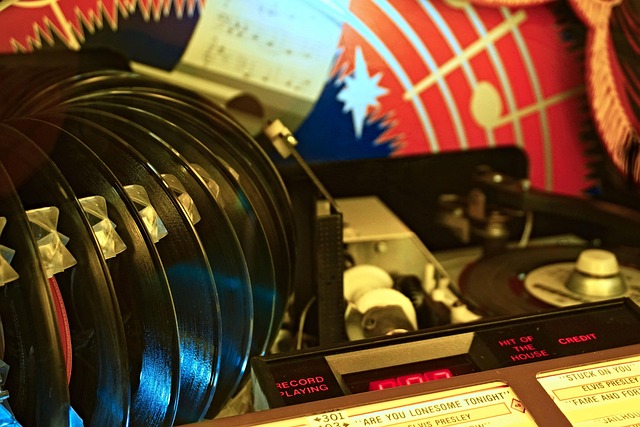Below is our definitive list of slang and technical terms related to jukeboxes, covering their design, operation, maintenance, components, and cultural significance. The list includes terminology from the golden age of jukeboxes (1930s–1960s), modern digital and reproduction models, and the associated vernacular from jukebox culture in diners, bars, and arcades. Jukeboxes, as coin-operated music machines, share some terms with arcade machines but have a unique lexicon tied to their audio and mechanical heritage. This list draws on the history of jukeboxes, their evolution, and their role in music and entertainment culture.
A
- Amplifier: The electronic component that boosts the audio signal to drive speakers, critical for sound quality in jukeboxes.
- Attract Mode: A feature where the jukebox plays music snippets, flashes lights, or displays visuals when idle to entice users to insert coins.
- Auto-Play: A setting where the jukebox plays songs automatically without coin insertion, often used in free-play mode or for background music.
B
- Background Music (BGM): A mode where the jukebox plays songs continuously at a lower volume, typically used in commercial settings to create ambiance.
- Bubble Tube: Decorative glass tubes filled with bubbling liquid, iconic in 1940s–1950s jukeboxes like Wurlitzer’s Model 1015, adding visual flair.
- Button Bank: The panel of buttons or keys used to select songs, often labeled with letters and numbers (e.g., A1, B2) for record or track selection.
C
- Cartridge: A component in some jukeboxes (e.g., Seeburg’s Select-O-Matic) that holds multiple records for automatic playback.
- Changer: Short for record changer, the mechanism that swaps records or CDs in multi-selection jukeboxes.
- Coin-Op: Short for coin-operated, referring to jukeboxes that require payment (coins or tokens) to play songs.
- Coin Mech: The mechanical or electronic device that accepts and validates coins or tokens, triggering song selection or credits.
- Credit: A song or play earned by inserting coins, tracked by the jukebox’s credit system.
- Cylinder Jukebox: An early jukebox (late 1800s–early 1900s) using wax cylinders instead of records, rare and predating disc-based models.
D
- Digital Jukebox: A modern jukebox using digital music files (e.g., MP3s) instead of physical records or CDs, often with touchscreens and internet connectivity.
- Disc Changer: A mechanism in CD or vinyl jukeboxes that selects and plays discs from a storage system, common in models like the Rock-Ola CD jukeboxes.
- Drop: Slang for inserting a coin into the jukebox, as in “Drop a quarter to play some tunes.”
E
- Electro-Mechanical: Older jukeboxes (pre-1980s) using a combination of mechanical parts and electrical circuits for operation, e.g., Wurlitzer’s 1100 series.
- EP: Extended Play, a 7-inch vinyl record with more tracks than a standard single, often used in jukeboxes for multiple songs per side.
F
- Flip Side: The B-side of a vinyl record, often selectable in jukeboxes, allowing players to choose the less popular song.
- Free Play: A setting where no coins are required to play songs, often used in private collections or promotional events.
G
- Gripper Arm: The mechanical arm in vinyl jukeboxes that picks up and moves records from the storage rack to the turntable.
- Grille: The decorative cover over the jukebox’s speakers, often designed to match the machine’s aesthetic, e.g., chrome or fabric in classic models.
H
- Hit: A popular song frequently played on a jukebox, often driving revenue for operators in high-traffic locations.
- Hotbox: Slang for a jukebox with a great selection of popular songs, attracting more plays.
I
- Input Selector: The interface (buttons, keyboard, or touchscreen) used to choose songs, often paired with a selection guide or title strip.
- Insert: The slot where coins or tokens are inserted to activate the jukebox.
J
- Juke: Slang for playing music on a jukebox, derived from the term’s origins in African-American vernacular meaning to dance or party.
- Jukebox: A coin-operated music-playing machine, historically using records, later CDs or digital files, named from “juke joints” where music and dancing occurred.
K
- Keyboard Selector: A button-based input system (e.g., letter-number combinations like A1, B2) used to select songs, common in vinyl and CD jukeboxes.
L
- Light Show: Coordinated lighting effects (e.g., bubble tubes, neon, or LEDs) that enhance the jukebox’s visual appeal, especially during attract mode.
- LP: Long Play, a 12-inch vinyl record, rarely used in jukeboxes due to size but occasionally found in specialty models.
M
- Marquee: A decorative sign or panel on the jukebox, often displaying the brand (e.g., Wurlitzer, Seeburg) or game-specific artwork.
- Mechanism: The collective term for the jukebox’s internal components that handle record or CD selection, playback, and return.
- Multi-Select: A feature allowing players to queue multiple songs per credit, common in modern and some classic jukeboxes.
N
- Needle: The stylus in a vinyl jukebox that reads the record’s grooves to produce sound, critical for audio quality.
- Nickelodeon: An early term for coin-operated music machines (late 1800s–early 1900s), sometimes applied to early jukeboxes or player pianos.
O
- Operator: The person or company responsible for maintaining, stocking, and collecting revenue from jukeboxes in commercial locations.
- Outrigger: A stabilizing component in some jukeboxes, particularly larger models, to prevent tipping during transport or heavy use.
P
- Phonograph: The record-playing component in vinyl jukeboxes, including the turntable, tonearm, and needle.
- Pilaster: Decorative vertical columns or panels on the jukebox’s exterior, often with lights or chrome, enhancing its aesthetic.
- Play Counter: A meter tracking the number of plays for each song, used by operators to determine popular tracks.
- Playlist: The collection of songs available on a jukebox, displayed via title strips or digital menus.
Q
- Quarter: The standard U.S. coin (25 cents) used in many jukeboxes, especially in the mid-20th century, synonymous with jukebox culture.
R
- Random Play: A feature where the jukebox selects and plays songs randomly, often used in background music mode.
- Record Rack: The storage system holding vinyl records in a jukebox, typically organized for automatic selection.
- Retro Jukebox: A modern reproduction of a classic jukebox design, often using digital technology but styled like 1940s–1950s models.
- RPM: Revolutions Per Minute, referring to the speed of vinyl records (e.g., 45 RPM for singles, 33⅓ RPM for LPs), with 45 RPM being standard for jukeboxes.
S
- Seeburg: A major jukebox manufacturer, known for innovations like the Select-O-Matic, which could play up to 100 records.
- Selector: The mechanism or interface (buttons, touchscreen) used to choose songs, paired with a credit system.
- Single: A 7-inch vinyl record with one song per side, the standard format for jukeboxes due to its compact size and quick play.
- Sound System: The collective audio components (amplifier, speakers, equalizer) that produce the jukebox’s music output.
- Speaker Grille: The protective and decorative cover over the jukebox’s speakers, often styled to match the machine’s theme.
- Spinner: A rotating display or mechanism in some jukeboxes, often used to show title strips or create visual effects.
T
- Title Strip: A paper or plastic label listing a song’s title, artist, and selection code (e.g., A1), displayed in the jukebox’s selection window.
- Tonearm: The arm in a vinyl jukebox that holds the needle and tracks across the record to play music.
- Transistorized: Refers to jukeboxes using transistor-based electronics (post-1960s), replacing vacuum tubes for improved reliability.
- Tune: Slang for a song played on a jukebox, as in “Play a tune for me.”
- Turntable: The rotating platform in a vinyl jukebox that spins the record during playback.
V
- Vacuum Tube: An older electronic component used in early jukeboxes (pre-1960s) for amplification, known for warm sound but less reliable than transistors.
- Vinyl Jukebox: A jukebox that plays 7-inch or 12-inch vinyl records, dominant from the 1930s to 1980s.
W
- Wallbox: A remote jukebox selector unit, often mounted on diner tables or walls, allowing song selection without approaching the main machine.
- Wurlitzer: A leading jukebox manufacturer, famous for iconic models like the 1015 “Bubbler” with its colorful, retro design.
Notes
- Historical Context: Terms like “nickelodeon” and “vacuum tube” are tied to early jukeboxes, while “digital jukebox” and “touchscreen” reflect modern designs.
- Cultural Slang: Terms like “juke,” “hotbox,” and “drop” are rooted in mid-20th-century American diner and bar culture.
- Manufacturer-Specific Terms: Brands like Wurlitzer and Seeburg introduced terms like “bubble tube” or “Select-O-Matic” tied to their innovations.
- Regional Variations: UK jukeboxes may use terms like “fruit machine” for gambling-adjacent devices, while “wallbox” is more common in U.S. diner settings.
Jukebox Buyer Resources
Jukebox Auctions – Vinyl Record Jukeboxes – CD Jukeboxes – Jukebox Records

